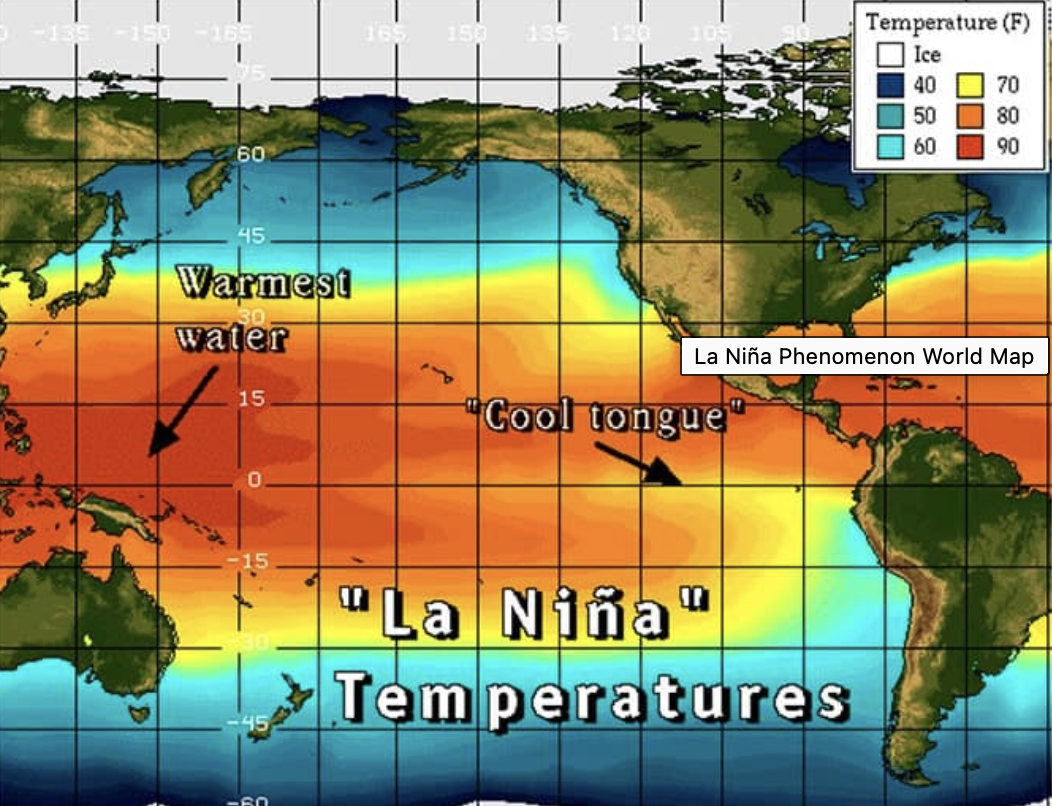Ecuador is currently facing the longest La Niña phenomenon in 120 years, with negative economic impacts on key sectors such as fishing and agriculture.
La Niña is an atmospheric phenomenon characterized by a drop in sea surface temperature, and typically lasts between nine months to three years. However, the current La Niña 2020-2023 has been the longest in the last 66 years, lasting for 34 months already, and is expected to continue until April 2023.
Impacts of La Niña on Fishing and Agriculture sectors
The fishing sector has been one of the most severely affected by the prolonged La Niña. The decrease in sea surface temperature has led to the migration of tropical fish such as tuna, causing a reduction in tuna fishing (and other fish), with exports dropping by 21.8% in 2022.
The southern season for tuna fishing, which sees Ecuadorian tuna vessels moving to Peruvian waters, has been particularly disappointing, with production costs increasing by 15% due to extended fishing trips and greater spending on fuel, lubricants, and crew food.
The minor fishing sector, which supplies the shrimp feed industry, has also been affected, with the market even importing fishmeal from Peru to meet its needs.
La Niña has also impacted agricultural production in Ecuador, causing droughts on the coast and affecting crops such as bananas.
In 2022, close to 80% of the drop in banana export volume was attributed to La Niña, with production per hectare decreasing from 45 to 35 bunches. Bananas typically develop properly in temperatures ranging from 25°C to 35°C, but La Niña has caused temperatures to drop to as low as 18°C, leading to reduced productivity.
Possible man-made solutions
To counteract the impacts of La Niña, the National Institute for Agricultural Research (Iniap) has worked with agricultural producers in three key areas: water collection, reduced tillage to zero, and the use of seeds that are more resistant to climate change.
Water collection involves the use of reservoirs to collect water from streams or mist, while reduced tillage creates a protective layer that prevents water loss and erosion. The use of seeds that are more resistant to climate change, such as the ‘Josefina’ potato produced in Chimborazo, can also help to mitigate the impacts of droughts.
While the La Niña phenomenon has had significant negative impacts on Ecuador’s fishing and agricultural sectors, there are steps that can be taken to increase resilience and prepare for future climate events. It is hoped that sea surface temperatures will begin to normalize in the coming months, allowing the country to recover from the prolonged La Niña.
Social impact of La Niña
The prolonged La Niña phenomenon has had a ripple effect on various other sectors in Ecuador, impacting infrastructure, the energy sector, and even the drinking water supply.
The low water levels in rivers and reservoirs have led to hydroelectric power shortages, causing Ecuador to import energy from neighboring countries, increasing energy costs. In addition, low water levels have also made it difficult for people in certain areas to access drinking water, with some communities having to rely on water deliveries.
The construction industry has also been impacted, with delays in construction projects due to the shortage of materials and the increased cost of raw materials, such as cement and steel. This has led to a slowdown in economic growth in the country, with the Ecuadorian government forecasting a 1.5% drop in GDP growth in 2022.
The impacts of the prolonged La Niña are also being felt in the transportation sector, with many roads and highways becoming impassable due to flooding and landslides. The Ministry of Transport and Public Works has had to close several roads and bridges, causing significant disruptions to transportation and commerce.
The La Niña phenomenon has also had a social impact, affecting the livelihoods of many Ecuadorians, particularly those in the coastal regions who rely on fishing and agriculture for their livelihoods.
Small-scale fishers and farmers have been hit particularly hard, as they lack the resources and infrastructure to adapt to the impacts of La Niña.
Efforts to mitigate the impacts of La Niña on key sectors
One such program is the Proadapt project, which was launched in 2017 with the aim of helping vulnerable communities adapt to climate change. The project has focused on providing technical assistance, training, and financial support to small-scale farmers and fishers, as well as promoting the use of climate-resilient farming and fishing practices. This has helped to increase the tolerance of these communities to the impacts of La Niña and other climate events.
Another important initiative is the National Strategy for Climate Change, which was launched in 2020. The strategy aims to promote sustainable development and increase resilience to climate change through measures such as promoting renewable energy, improving water management, and strengthening disaster risk reduction measures.
It is also important to note that the impacts of La Niña are not limited to Ecuador but are felt across the globe. In 2022, La Niña caused extreme weather events in various parts of the world, including droughts in South Africa, floods in Australia, and cold snaps in North America. This highlights the need for a global response to climate change, with countries working together to mitigate its impacts and increase adaptation to its effects.


0 Comments